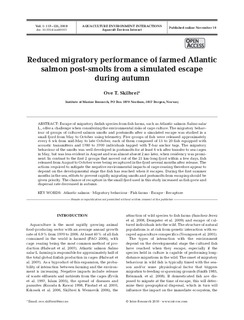Reduced migratory performance of farmed Atlantic salmon post-smolts from a simulated escape during autumn
Original version
http://dx.doi.org/10.3354/aei00013Abstract
Escape of migratory finfish species from fish farms, such as Atlantic salmon Salmo salar L., offer a challenge when considering the environmental risks of cage culture. The migratory behaviour of groups of cultured salmon smolts and postsmolts after a simulated escape was studied in a small fjord from May to October using telemetry. Five groups of fish were released approximately every 6 wk from mid-May to late October, each of them composed of 15 to 20 fish equipped with acoustic transmitters and 1780 to 3700 individuals tagged with T-bar anchor tags. The migratory behaviour of the smolts was well developed in postsmolts for at least 6 wk after transfer to sea cages in May, but was less evident in August and was almost absent 2 mo later, when residency was prominent.
In contrast to the first 2 groups that moved out of the 21 km-long fjord within a few days, fish released from August to October were being recaptured in the fjord several months after release. The actions required to mitigate the negative environmental impacts of cage-rearing therefore appear to depend on the developmental stage the fish has reached when it escapes. During the first summer months in the sea, efforts to prevent rapidly migrating smolts and postsmolts from escaping should be given priority. The chance of recapture in the small fjord used in this study increased as fish grew and dispersal rate decreased in autumn.
